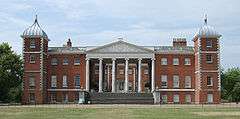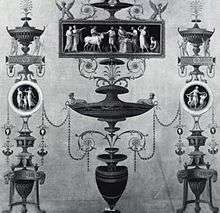Osterley Park
| Osterley Park | |
|---|---|
 | |
| General information | |
| Type | Mansion |
| Location | Jersey Road, Isleworth, Hounslow, London, England |
| Coordinates | 51°29′21.75″N 00°21′07.14″W / 51.4893750°N 0.3519833°WCoordinates: 51°29′21.75″N 00°21′07.14″W / 51.4893750°N 0.3519833°W |
| Construction started | 1761 |
| Technical details | |
| Material | Red brick |
| Design and construction | |
| Architect | Robert Adam |
| Website | |
|
www | |

Osterley Park is a mansion set in a large park of the same name. It is in the London Borough of Hounslow, part of the western suburbs of London.
When the house was built it was surrounded by rural countryside. It was one of a group of large houses close to London which served as country retreats for wealthy families, but were not true country houses on large agricultural estates. Other surviving country retreats of this type near London include Syon House and Chiswick House. The park is one of the largest open spaces in west London, although the M4 motorway cuts across the middle of it.
History
Elizabethan
The original building on this site was a manor house built in the 1570s for banker Sir Thomas Gresham, who purchased the manor of Osterley in 1562.[1] The "faire and stately brick house" was completed in 1576. It is known that Queen Elizabeth visited.[2] The stable block from this period remains at Osterley Park. Gresham was so wealthy he also bought the neighbouring Manor of Boston in 1572.
Child and Adam
Two hundred years later the manor house was falling into disrepair, when, as the result of a mortgage default, it came into the ownership of Sir Francis Child, the founder of Child's Bank. In 1761 Sir Francis's grandsons, Francis and Robert, employed Scottish architect Robert Adam, who was just emerging as one of the most fashionable architects in Britain, to remodel the house. When Francis died in 1763, the project was taken up by his brother and heir Robert Child, for whom the interiors were created.
The house is of red brick with white stone details and is approximately square, with turrets in the four corners. Adam's design, which incorporates some of the earlier structure, is highly unusual, and differs greatly in style from the original construction. One side is left almost open and is spanned by an Ionic pedimented screen which is approached by a broad flight of steps and leads to a central courtyard, which is at piano nobile level.
Adam's neoclassical interiors are among his most notable sequences of rooms. Horace Walpole described the drawing room as "worthy of Eve before the fall." The rooms are characterised by elaborate but restrained plasterwork, rich, highly varied colour schemes, and a degree of coordination between decor and furnishings unusual in English neoclassical interiors. Notable rooms include the entrance hall, which has large semi-circular alcoves at each end, and the Etruscan dressing room, which Adam said was inspired by the Etruscan vases in Sir William Hamilton's collection, illustrations of which had recently been published. Adam also designed some of the furniture, including the opulent domed state bed, still in the house.


After Child
Robert Child's only daughter, Sarah Anne Child, married John Fane, 10th Earl of Westmorland in 1782. When Child died two months later, his will placed his vast holdings, including Osterley, in trust for his eldest granddaughter, Lady Sarah Sophia Fane, who was born in 1785. She married George Child-Villiers, 5th Earl of Jersey, and thus Osterley passed into the Jersey family.
Home Guard Training Establishment
The grounds of Osterley Park were used for the training of the first members of the Local Defence Volunteers (forerunners of the Home Guard) when the 9th Earl, a friend of publisher Lord Hulton, allowed writer and military journalist Captain Tom Wintringham to establish the first Home Guard training school (which Hulton sponsored) at the park in May/June 1940, teaching the theory and practice of modern mechanical warfare, guerilla warfare techniques and using the estate workers' homes, then scheduled for demolition, to teach street fighting techniques.[3] The painter Roland Penrose taught camouflage techniques here,[4] attempting to disguise the obvious charms of a naked Lee Miller. Maj. Wilfred Vernon taught the art of mixing home-made explosives, and his explosives store can still be seen at the rear of the house, while Canadian Bert "Yank" Levy, who had served under Wintringham in the Spanish Civil War taught knife fighting and hand-to-hand combat. Despite winning world fame in newsreels and newspaper articles around the world (particularly in the US), the school was disapproved of by the War Office and Winston Churchill, and was taken over in September 1940. Closed in 1941, its staff and courses were reallocated to other newly opened WO-approved Home Guard schools.[3]
Postwar history
George Child Villiers, 9th Earl of Jersey opened Osterley to the public in 1939 after having received many requests to see its historic interior.[5] The Earl justified his decision by saying that it was "sufficient answer that he did not live in it and that many others wished to see it"; some 12,000 people subsequently visited the house in its first month of opening.[5] A series of exhibitions of artworks by living artists were staged by the Earl in the top-floor rooms of Osterley to contrast the 18th-century interiors on the ground floor on its 1939 opening.[5] Though it never came to fruition, the Earl planned to create an arboretum in the grounds of Osterley.[5]
After the Second World War the Earl approached Middlesex County Council who had shown interest in purchasing the house before the war, but eventually decided to give the house and its park to the National Trust.[5] The furniture at Osterley was sold to the Victoria & Albert Museum.[5] The 9th Earl moved to the island of Jersey in 1949, taking many pictures from Osterley's collection with him, although some were destroyed in a warehouse fire on the island soon after.[5] The Earl assisted the Ministry of Works and V&A in their restoration of the house to its present late 18th-century state.[5]
The National Trust took charge of Osterley in 1991, and received many loans and gifts from Lord Jersey including items of silver, porcelain, furniture and miniatures.[5] The trust commissioned portraits of Lord Jersey and his wife by Howard Morgan, which are hung upstairs.[5] In 2014 a ten-year loan to Osterley of portraits of the Child family was arranged by William Villiers, 10th Earl of Jersey, the present Earl.[6] Portraits included in 2014 loan include Allan Ramsay's portrait of Francis Child (1758), and George Romney's portrait of Francis's brother, Robert.[6]
The house and gardens are open to the public and receive around 30,000 of the 350,000 visitors to the surrounding park.[7] The park is the site of a weekly 5k Parkrun.[8]
In popular culture
Television
- The house featured in several ITC series in the 1960s and 70s, including an episode of The Saint entitled "The Angel's Eye" starring Roger Moore, and an episode of The Persuaders! called "The Morning After" which also starred Moore, alongside Tony Curtis.
- Osterley Park was originally proposed as the setting (and location) for the 1973 Doctor Who serial Day of the Daleks. The name was changed to "Auderley" in the finished programme, and was renamed "Austerley" in the novel of the serial. The location eventually used was Dropmore Park in Buckinghamshire.
- The entrance hall of the house also appeared as a room in an upmarket central London hotel in the denouement of the 2007 ITV adaptation of At Bertram's Hotel.
- Osterley Park was used as the home of billionaire Sir Peter Maxwell, for the 2006 TV pilot, 'Maxwell: Inside the Empire'.
- ChuckleVision was also filmed in Osterley Park.
- Many of the Horrible Histories episodes were filmed in Osterley House and Gardens.
Film
- The 1960 film The Grass Is Greener, starring Cary Grant, Deborah Kerr, and Robert Mitchum, was set and partly shot at Osterley Park House.
- Osterley Park has been used for Buckingham Palace scenes, including Victoria's sitting room and anteroom, in the 2009 film The Young Victoria starring Emily Blunt and Rupert Friend.
- The 1984 film Top Secret!, starring Val Kilmer and Omar Sharif, features Osterley as East Berlin Town Hall, when the various cultural ambassadors are presented with medals by the East German Women's Olympic Team.
- In the 2012 Batman film The Dark Knight Rises, the interior of Osterley Park mansion is used as a double for Wayne Manor.[9]
Literature
- Osterley Park features in John Banville's novel The Untouchable.
Images
 The main mansion
The main mansion Side of the mansion
Side of the mansion Courtyard of the mansion
Courtyard of the mansion Ceiling
Ceiling Columns at the front of the mansion
Columns at the front of the mansion View from the mansion over the estate
View from the mansion over the estate The stables, now a cafe
The stables, now a cafe Turret at the stable
Turret at the stable Farmland in Osterley Park
Farmland in Osterley Park
References
- ↑ John Hardy and Maurice Tomlin, Osterley Park House, (Victoria and Albert Museum) 1985.
- ↑ Jayne Elisabeth Archer, Elizabeth Clarke, and Elizabeth Goldring, eds, John Nichols' The Progresses and Public Processions of Queen Elizabeth I: A New Edition of the Early Modern Sources, V: Appendices, Bibliographies, and Index. Appendix 7: Sir Thomas Gresham and Osterley Park
- 1 2 Tom Wintringham (History Learning Site) accessed 29 Jan 2008
- ↑ Newark, Tim Now you see it... Now You Don't, (March 2007) History Today
- 1 2 3 4 5 6 7 8 9 10 Anthea Palmer (24 August 1998). "Obituary: The Earl of Jersey". The Independent. Retrieved 24 July 2014.
- 1 2 Maev Kennedy (26 February 2014). "Osterley Park welcomes home its family portraits". The Guardian. Retrieved 24 July 2014.
- ↑ "Strategis - Osterley". Strategis. Retrieved 21 July 2014.
- ↑ "Parkrun - Osterley". Parkrun. Retrieved 21 July 2014.
- ↑ 73 Like27 Dislike0 28 May 2011 by B. Alan Orange (2011-05-28). "The Dark Knight Rises". Movieweb.com. Retrieved 2013-09-09.
External links
| Wikimedia Commons has media related to Osterley Park. |
- Osterley Park information at the National Trust
- Aerial photo and map
- Flickr images tagged Osterley Park
- A Brief History of Osterly Park by the Dowager Countess of Jersey, 1920

